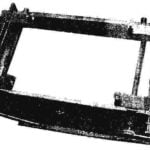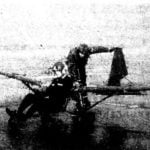Pilot boat “Environmentalist” 1459:
1 — anchor light (white), 2 — shtag-rail, 3 — lifeline (4 PCs), 4 — vent the end walls, 5 — the wheelhouse, 6 — spotlight 7 — antenna navigation radar, 8 — pole 9 — masthead light (white), 10 — speaker, 11 — antenna, HF and VHF radio stations, 12 fire mavroyeni, 13 — kotikovye lights (2 white, 1 red), 14 ceiling, deck lighting, 15 — stern light (white), 16 — fire equipment, 17 — extinguishers, 18 — trash, 19 — Davit for lowering boats, 20 — flag pole, 21 – bale strap, 22 — fender, £5— brand deepening, 24 — rudder 25 — bracket screw, 26 — hatch in the forepeak, a 27 — cleats cross, 28 — anchor capstan, a 29 — chain stopper, 30 — view, 31 —a spare anchor, a 32 — locker, 33 — side a distinctive fire (red), 34 — Typhon 35 containers of liferafts, 36 — light hatch of the engine room, 37 — cap the engine room, a 38 — month, 39 — power supply cable from the shore, a 40—power distribution Board, 41 — the keel blocks of the boat, a 42 — hatch in the stern sections, 43 — emergency hatch of the engine room, 44 — onboard distinctive fire (green), 45 — impulse lamp of the “signal” (two on each side), 46 — bow fender, a 47 — plastic boat “Pella”.
The anchor device consists of two anchors Hall (main and spare) with a mass of 150 kg each and the stop anchor. The rise and impact of the implemented anchors manual anchor-mooring spire.
In the area of the midship-frame located ladder-guy, intended for the disembarkation of the pilot serviced the ship.
Rescue tools include life preservers and two inflatable rafts of PSN type-6 with capacity for 6 people each, placed in two plastic containers on the Cape of the engine room.
For fire-fighting boat equipped with fire-fighting water system, and for fire fighting in the engine room provided for the use of the composition of BF-2.
Water heating system capable of maintaining normal temperature in all rooms when outside air temperatures down to -25° C.
These simple, but reliable and need small boats was built, in particular, the Leningrad shipyard “Pella”, they are well known in our country and abroad, as exported to the CMEA countries. In the middle of 80-ies brought attention to the then nascent services environmental control. The lack of special courts has led ecologists to the need to explore options for the use of already developed industry projects with high technical and operational characteristics: good seaworthiness, shallow draft, the ability of scientific equipment. However, it was required to make a number of changes to the structure of the boat. But they were not of a fundamental nature. Initially developed boats that were in operation, and then began to receive the court, already re-equipped in the factory.
Their main difference from the basic pilot project was the lack of a ladder-cable, the Windows on the bevel of the roof and pilot lights. The need for sampling of the water close to the shore, from the exhaust manifolds, businesses and other places where the boat because of its precipitation approach could not have led to the emergence of aft additional watercraft (Motorboats of the type “Progress”, “Kazanka”, etc.). Built on the shipyard “Pella” “Ecologists” staffed plastic boat “Pella”. For its placement on the stern additionally equipped with keel blocks.
The drawing shows a boat 1459 the construction of the shipyard “Pella” as of July 1989, used for the needs of the environmental services of the basin of the Neva river in St. Petersburg. It is well suited for production of a model with a hull length of up to 600 mm. Under the wheelhouse and capom engine room easily houses the hatch for access to the mechanisms of the model, and the presence of two propellers and rudders model provides good maneuvering qualities. A fairly complete hull lines allow to accommodate all necessary equipment and equipment. When building models in class, YONG-in connection with a large area of glazing in the wheelhouse for high bench evaluation is desirable to study its interior.
PAINTING THE MODEL:
LIGHT GREY — freeboard, antenna radar, searchlight, horn, VHF antenna, equipment in the wheelhouse;
MINIUM IRON – the underwater part of the hull;
WHITE wheelhouse and cap the engine room, mast, railing, waterline, mark the deepening of the boat (inside);
GREEN — deck, the roof of the wheelhouse and the engine room cap from above;
RED — the distinctive stripe on the tube, emergency tool, fire extinguishers;
ORANGE lifebuoys;
GOLDEN — logo on the tube;
BLACK — anchor chain stopper, windlass, cleats, bale strap, reflective shields, fender, bow fender, labels on containers of liferafts, the label “ENVIRONMENTALIST” and “GOSPODINCI-TION”;
EMERALD GREEN – the boat outside.
C. Solodov,
E. IT, Vladimir
Recommend to read
 EASY GOING
EASY GOING
In the "Modeller-designer" has repeatedly published materials on woodworking machines-"circular saw" circular saw and planer, so necessary for the house masters. On this publication have... THE PLANE, WHICH IS EASIER TO PILOT
THE PLANE, WHICH IS EASIER TO PILOT
Ultralight aircraft V. Dmitrieva series X-14 a few years ago aroused great interest among aviation enthusiasts and professionals, attracting its originality. They exhibited at the...
 Many of you probably noticed that the wiring of cargo ships in the mouths of rivers, on inland waterways and open sea raids using special vessels with a large inscription on Board the “PILOT”. This is a pilot trial. In accordance with the standard of their share on the botton with a displacement of up to 10 tons, boats with a displacement of 10 — 250 tons and the actual pilot vessels. In Russia are in operation all of the above types of pilot boats.
Many of you probably noticed that the wiring of cargo ships in the mouths of rivers, on inland waterways and open sea raids using special vessels with a large inscription on Board the “PILOT”. This is a pilot trial. In accordance with the standard of their share on the botton with a displacement of up to 10 tons, boats with a displacement of 10 — 250 tons and the actual pilot vessels. In Russia are in operation all of the above types of pilot boats.
